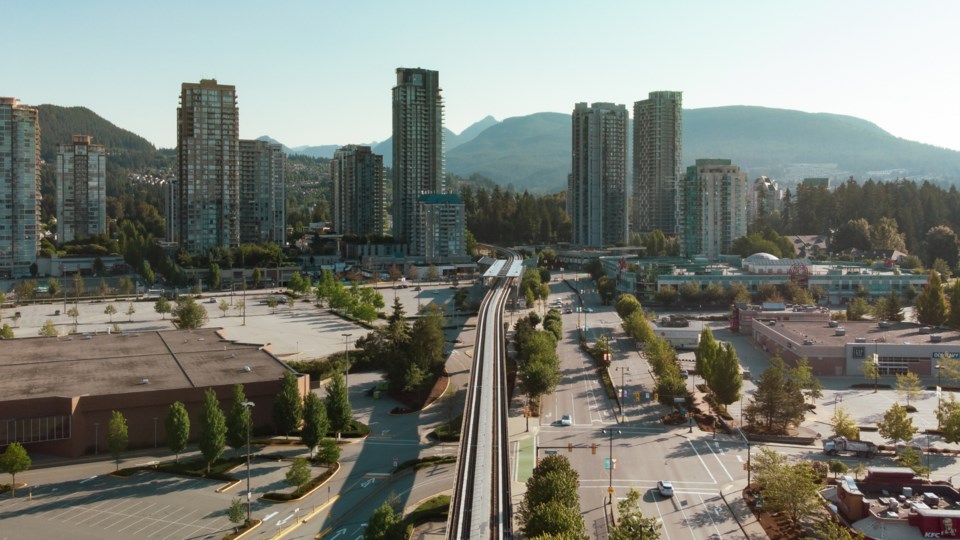The Tri-Cities region is poised for economic growth, with a significant number of projects underway despite industry-wide challenges like high construction costs and razor-thin profit margins.
“Our main advantage is that we’re geographically in the middle of Metro Vancouver, and as the population shifts slowly eastward, we become that hub of both logistics and population, the economic development hub in Metro Vancouver,” said Richard Stewart, mayor of Coquitlam, the largest of the region’s three municipalities that also include Port Coquitlam and Port Moody.
A game-changer was the arrival of SkyTrain with the Evergreen line’s opening in 2016.
“It had been promised for about 30 years,” Stewart said. “That allowed Coquitlam to identify transit-oriented areas that could receive high-density office space, high-density commercial and residential occupancies, and in fact we started developing those neighbourhoods even before SkyTrain was built.”
Now, the city is focusing density in Coquitlam Centre, which has three rapid transit stations on the Pinetree corridor, and around Lougheed mall in the Burquitlam corridor bordering Burnaby.
Stewart said the city has tried to maintain stability and certainty for developers regarding fee and cost structures for density. He also said his council is delivering infrastructure to support growth.
“It’s really important … that we ensure the transportation networks are identified, improved and completed, and that we can support, through infrastructure, the kinds of development that we need to play our role as a central figure in Metro Vancouver,” he said.
Industrial focus
Just east of Coquitlam where the Pitt and Fraser rivers meet, Port Coquitlam (PoCo) is ideally located to facilitate commercial activity and distribution to Mission and beyond via Lougheed Highway.
“It has pretty good access to get to the Port Mann Bridge, and now with the Golden Ears Bridge, traffic through Port Coquitlam can … get to the other side of the Fraser River,” said Kevin Volz, vice-president, industrial, with brokerage Cushman & Wakefield.
This is driving new industrial projects such as Pivotal 2 by Conwest Developments in northeast PoCo. Of its 26 small-bay industrial strata units, 25 have sold to owner-users including high-tech and fitness groups.
Another project, currently in the approvals process at city hall, is 2372 Fremont St., also in the northeast section of PoCo. These are mostly small-bay, 3,000-to-4,000-square-foot units mixing office and industrial.
Before 2022, when interest rates were lower and the economy was growing, companies could afford down payments of up to 40 per cent, Volz said. With limited avenues for high-ratio financing, better market conditions will hinge on businesses enjoying stronger cash flows that can support investment.
Homing instinct
The slow pace of residential development around two of the new Evergreen line SkyTrain stations won Port Moody a spot on the provincial government’s “naughty list” in September 2023, but the tide is turning.
Port Moody acting mayor Kyla Knowles said 168 new housing units became ready for occupancy in 2024, mostly in mid- and low-rise buildings. This year, the city anticipates 687 new condos, market and below-market rental units under building permits issued by the previous council.
Significant projects include Inlet District by Wesgroup, two 39-storey buildings by PCI Developments in Moody Centre, and three towers with 981 units in Moody Centre by Beedie Living set to go to public hearing early this year.
One notable development under construction is Portwood by Edgar Development, a 23-acre master-planned community that will have 2,000 homes when complete.
The site will have retail, about eight acres of open green space, a 1.5-kilometre nature trail and a 12,000-square-foot daycare.
While the smallest of the Tri-Cities, Port Moody is ideally located for future development.
“We’re 30 minutes from downtown, we have SkyTrain,” Knowles said. “We are close enough to the city that we can zip in and out, but we do still have that small-town feel right on the water.”





